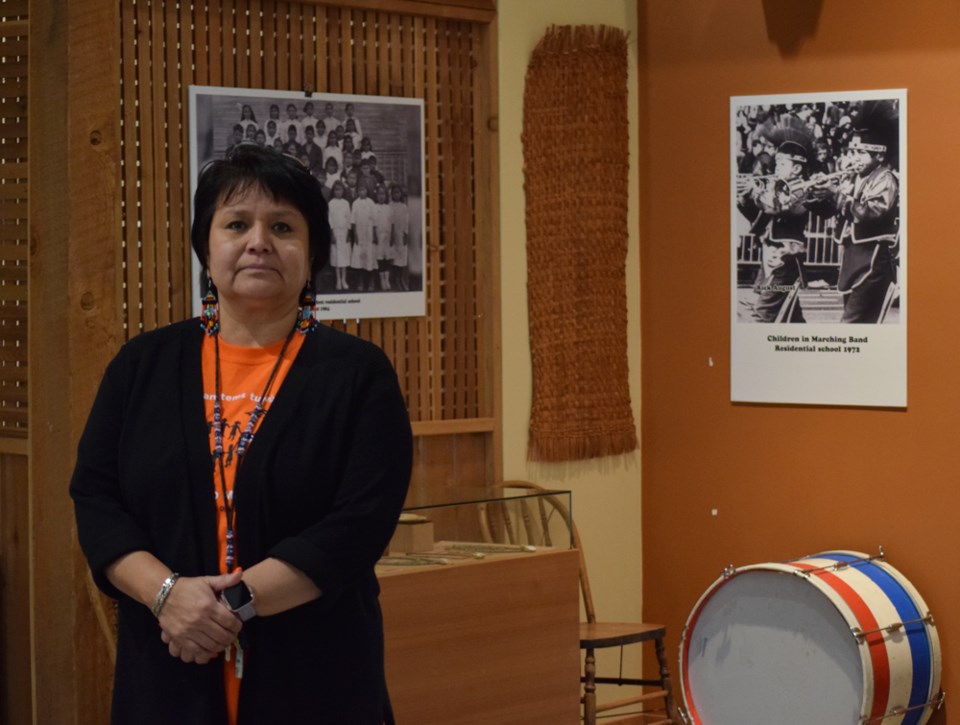As of Tuesday, the public has a unique opportunity to absorb the history of residential school on the Sunshine Coast at tems swiya Museum.
“It’s right here in our community. We can’t not tell this history,” said Raquel Joe, the museum’s curator. “If you live here you must come and see this.”
The new exhibit, kelkelus ?e she welh xwuxwulh t’i walh wixiw tems staw [Tears of the Past Revealing our True Story], was unveiled at the shíshálh Nation museum following a poignant ceremony for Orange Shirt Day – a national day of remembrance honouring survivors of residential school.
“It was planned for today with the ceremony and with Orange Shirt Day and the movement. It was something that felt right,” said Steven Feschuk, shíshálh Nation’s protector of culture, who emceed the Orange Shirt Day gathering held at the site of the Nation’s residential school monument on Sept. 30.
Following speeches from elders, prayers and song, the crowd of approximately 100 who gathered for the ceremony were invited inside the museum, where photographs of residential school buildings and students have been mounted to the walls next to artefacts, including a student’s chair and a large bass marching drum painted blue, white and red.
Some images are graphic, such as a strap and handcuffs used on children. Equally unequivocal are text displays of the accounts of elders who were physically abused and barred from speaking their language and practising their customs.
Daphne Paul is the sole living survivor who provided testimony of her experience as a day scholar. “She still can’t bring herself to come in here to check out this exhibit,” Joe said.
While these details have proven raw for many, including for Joe, who is a descendent of a residential school survivor and day scholar, elders in the community gave Joe permission to convey the stories. “They said yes, tell everything.”
The exhibit will be featured, with some modifications, in the upcoming Sechelt Arts Festival Fusion exhibition, which runs from Oct. 4 to 20.
Both Feschuk and Joe hope the exhibit will satisfy a public interest in understanding the history of residential school on the Sunshine Coast, as well as to inform those unaware of what Feschuk described as “Canada’s dark secret.”
That history reaches back to 1904, when the first school was built, largely using shíshálh Nation’s own resources with the intention of teaching students English, to bring “a new generation, one foot into this new world,” said Feschuk.
After the school burned down in 1917, a second school – “the brick school” – was built, this time with funds from the Canadian government as part of the residential school system. It opened in 1922. “That was really when things changed,” Feschuk said. Eventually, students from 48 First Nations across B.C. were legally required to attend that school.
The residential school closed in June 1975 and was burned to the ground by survivors later that year. The last remaining building, which housed the Nation’s administrative offices, was destroyed in 2008.
During the Orange Shirt Day ceremony, the raw accounts from survivors underscored the intergenerational trauma caused by the residential school system, but Feschuk also signalled a shift towards recovery.
Survivors and their descendants from other First Nations are returning to the site. Last Saturday, for example, members from Lil’wat Nation travelled to the shíshálh siywa for a healing ceremony. And the site of the last school building is now where master carver Tony Paul is working on his reconciliation pole, with help from the wider public and a grassroots reconciliation movement called syiyaya.
And, Feschuk noted, T-shirts designed by Tony Paul were being worn at all of the schools on the Sunshine Coast, memorializing history in “a sea of orange.”
“We’re not going to forget our past, we’re not going to forget what happened in that residential school, but we have to look forward to our future, we have to look forward to where we’re going,” he said.



